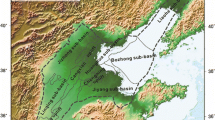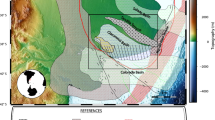Abstract
Based on the data of geo-temperature and thermophysical parameters of rocks in the Kuqa Depression and the Tabei Uplift, northern flank of the Tarim Basin, in terms of the analytical solution of 1-D heat transfer equation, the thermal structure of the lithosphere under this region is determined. Our results show that the average surface heat flow of the northern flank of the Tarim Basin is 45 mW/m2, and the mantle heat flow is between 20 and 23 mW/m2; the temperature at crust-mantle boundary (Moho) ranges from 514°C to 603°C and the thermal lithosphere where the heat conduction dominates is 138–182 km thick. Furthermore, in combination with the P wave velocity structure resulting from the deep seismic sounding profile across this region and rheological modeling, we have studied the local composition of the lithosphere and its rheological profile, as well as the strength distribution. We find that the rheological stratification of the lithosphere in this region is apparent. The lowermost of the lower crust is ductile; however, the uppermost of the mantle and the upper and middle parts of the crust are both brittle layers, which is typically the so-called sandwich-like structure. Lithospheric strength is also characterized by the lateral variation, and the uplift region is stronger than the depression region. The lithospheric strength of the northern flank of the Tarim Basin decreases gradually from south to north; the Kuqa Depression has the lowest strength and the south of the Tabei Uplift is strongest. The total lithospheric strength of this region is4.77×1012–5.03×1013 N/m under extension, and 6.5×1012–9.4×1013 N/m under compression. The lithospheric brittleductile transition depth is between 20 km and 33 km. In conclusion, the lithosphere of the northern flank of the Tarim Basin is relatively cold with higher strength, so it behaves rigidly and deforms as a whole, which is also supported by the seismic activity in this region. This rigidity of the Tarim lithosphere makes it little deform interior, but only into flexure under the sedimentation and tectonic loading associated with the rapid uplift of the Tianshan at its northern margin during the Indian-Eurasian continental collision following the Late Eocene. Finally, the influences of factors, such as heat flow, temperature, crustal thickness, and especially basin sediment thickness, on the lithospheric strength are discussed here.
Similar content being viewed by others
References
Monlar, P., Continental tectonics in the aftermath of plate tectonics, Nature, 1988, 335: 131–137.
Ranalli, G., Donald, C. M., Rheological stratification of the lithosphere, Tectonophysics, 1987, 132: 281–295.
Ranalli, G., Rheology of the Earth (2nd ed.), London: Chapman & Hall, 1995, 360–365.
Chen, W. P., Molnar, P., Focal depths of intracontinental and interpolate earthquake and their implication for the thermal and mechanical properties of the lithosphere, J. Geophys. Res., 1983, 88: 4183–4214.
Ranalli, G., Rheology of the lithosphere in space and time, in Orogeny Through Time (eds. Burg, J. P., Ford, M.), London: The Geological Society, 1997, 19–37.
Wang Liangshu, Li Cheng, Yang Chun, Thermal structure of the lithosphere beneath the Tarim Basin, Western China, Chinese Journal of Geophysics (in Chinese), 1997, 40(1): 51–62.
Wang Liangshu, Li Cheng, Liu Futian et al., Thermal-rheological structure of the lithosphere beneath two types of basins in eastern and western China, Science in China, Ser. D, 2000, 43(Suppl.): 200–207.
Shi Xiaobin, Zhou Di, Zhang Yixiang, Lithospheric thermalrheological structures of the continental margin of the northern South China Sea, Chinese Science Bulletin, 2000, 45(22): 2107–2112.
Shi Xiaobin, Zhou Di, Qiu Xuelin et al., Thermal and rheological structures of the Xisha Trough, South China Sea, Tectonophysics, 2002, 351: 285–300.
Zang Shaoxian, Liu Yonggang, Ning Jieyuan, Thermal structure of the lithosphere in North China, Chinese Journal of Geophysics (in Chinese), 2002, 45(1): 56–66.
Zang Shaoxian, Li Chang, Ning Jieyuan et al., A primary model for the 3-D rheological structure of the lithosphere in North China, Science in China, Ser. D, 2003, 46(5): 461–473.
Lin Chuangyong, Shi Lanbin, Han Xiuling et al., Thermal structure and rheology of upper mantle beneath Zhejiang Province, China, Science in China, Ser. D, 1998, 41(2): 171–178.
Zhou Zhenheng, Xiang Caiying, Qin Yuxi et al., Study on deep heat flow in Yunnan, China, Northwestern Seismological Journal (in Chinese), 1997, 19(4): 51–57.
Lu Huafu, Howell, D. G., Jiang Dong et al., Rejuvenation of the Kuqa foreland basin, Northern flank of the Tarim basin, North- west China, International Geology Review, 1994, 36: 1151–1158.
Avouac, J. P., Tappnnier, P., Bai, M. et al., Active thrusting and folding along the northern Tienshan and Cenozoic rotation of the Tarim relative to Dzungaria and Kazakhstan, Jour. of Geophy. Res., 1993, 98(B4): 6755–6804.
Jia Chengzao, Tectonic Characteristics and Petroleum, Tarim Basin, China (in Chinese), Beijing: Petroleum Industry Press, 1997, 348–357.
Zhang Jiaru, Shao Xuezhong, Fan Huiji, Deep sounding survey by converted waves of earthquakes in central part of Tarim Basin and its interpretation, Seismology and Geology (in Chinese), 1998, 20(1): 34–42.
Ketcham, R. A., Distribution of heat producing elements in the upper and middle crust of southern and west central Arizona: Evidence from the core complexes, J. Gephys. Res., 1996, 101: 13611–13632.
Rybach, L., Buntebarth, G., The variation of heat production, density and seismic velocity with rock type in the continental lithosphere, Tectonophysics, 1984, 103: 335–344.
Cermak, V., Bodri, L., A heat production model of the crust and upper mantle, Tectonophysics, 1991, 194: 307–323.
Wang Jiyang, Wang Ji’an, Thermal structure of the crust and upper mantle of Liaohe rift basin, North China, Science in China, Ser. B, 1987, 30(5): 553–560.
Qiu Nansheng, Characteristics of thermal conductivity and radiogenic heat production rate in basin of northwest China, Chinese Journal of Geology (in Chinese), 2002, 37(2): 196–206.
Artemieva, I. A., Mooney, W. D., Thermal thickness and evolution of Precambrian lithosphere: A global study, J. Geophys. Res., 2001, 106 (B8): 16387–16414.
Hu Shengbiao, Wang Jiyang, Heat flow, deep temperature and thermal structure across the orogenic belts in Southeast China, J. Geody., 2000, 30: 461–473.
Seipold, U., Depth dependence of thermal transport properties for typical crustal rocks, Phys. Earth Planet. Inter., 1992, 69: 299–303.
Chapman, D. S., Thermal gradients in the continental crust, in The Nature of the Lower Continental Crust (eds. Dawson, J. B., Carswell, D. A., Wedepohl, K. H.), London: Geological Society Special Publication, 1986, 24: 63–70.
Sibson, R. H., Frictional constrains on thrust, wrench, and normal faults, Nature, 1974, 249: 542–544.
Kirby, S. H., Rheology of the lithosphere, Rev. Geophy. Space Phys., 1983, 21: 1458–1487.
Hopper, J. R., Buck, W. R., The initiation of the rifting at constant tectonic force: Role of diffusion creep, J. Geophys. Res., 1993, 98: 16213–16221.
Miosio, K., Kaikkonen, P., Beekman, F., Rheological structure and dynamic response of the DSS profile BALTIC in the SE Fennoscandian Shield, Tectonophysics, 2000, 320: 175–194.
Kusznir, N. J., Park, R. G., Continental lithosphere strength: the critical role of lower crustal deformation, in The Nature of the Lower Continental Crust (eds. Dawson, J. B., Carswell, D. A., Wedepohl, K. H.), London: Geological Society Special Publication, 1986, 24: 79–93.
Wang Liangshu, Li Cheng, Liu Shaowen et al., Characteristics of geotemperature gradient distribution in the Kuqa foreland basin of north edge of the Tarim, western China, Chinese J. of Geophysics, 2003, 46(3): 575–581.
Lavier, L. L., Steckler, M. S., The effect of sedimentary cover on the flexture strength of continental lithosphere, Nature, 1997, 389: 476–479.
Wang Liangshu, Li Cheng, Liu Shaowen et al., Distribution feature of terrestrial heat flow densities in the Bohai Basin, East China, Chinese Science Bulletin, 2002, 47(10): 857–862.
Zhang Jian, Wang Jiyang, The deep geothermal characteristics of continental margin of the northern South China Sea, Chinese Science Bulletin, 2000, 45(18): 1717–1722.
Hu Shengbiao, He Lijuan, Wang Jiyang, Heat flow in the continental area of China: A new data set, Earth and Planetary Science Letters, 2000, 179: 407–419.
Wang Liangshu, Shi Yangshen, Geothermal Study on Oil and Gas Basin (in Chinese), Nanjing: Nanjing University Press, 1989, 34–42.
Xu Yi, Liu Futian, Liu Jianhua, Seismic tomography beneath the orogenic belts and adjacent basins in northwestern China, Science in China, Ser. D, 2001, 44(5): 468–480.
Lynch, H. D., Morgan, P., The tensile strength of the lithosphere and the localization of extension, in Continental Extensional Tectonics (eds. Coward, M. P., Dewey, J. F., Hancock, P. L. et al.), London: Geo. Soc. Spec. Publ., 1987, 28: 53–66.
Li Cheng, Wang Liangshu, Guo Suiping et al., Thermal evolution of Tarim Basin, Acta Petroleum Sinica (in Chinese), 2000, 21(3): 13–17.
Zhang Guomin, Wang Suyun, Li Li et al., Focal depth research of earthquakes in mainland China, Chinese Science Bulletin, 2002, 47(12): 969–974.
Author information
Authors and Affiliations
Corresponding author
Rights and permissions
About this article
Cite this article
Liu, S., Wang, L., Li, C. et al. Thermal-rheological structure of lithosphere beneath the northern flank of Tarim Basin, western China: Implications for geodynamics. Sci. China Ser. D-Earth Sci. 47, 659–672 (2004). https://doi.org/10.1360/03yd0471
Received:
Revised:
Issue Date:
DOI: https://doi.org/10.1360/03yd0471




